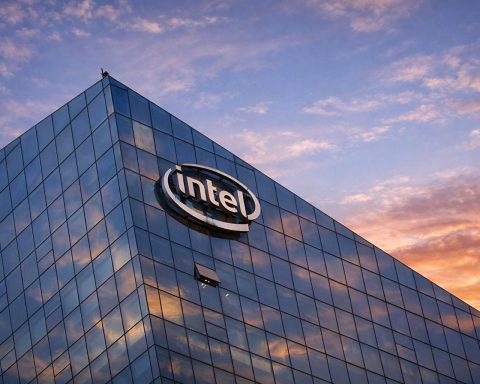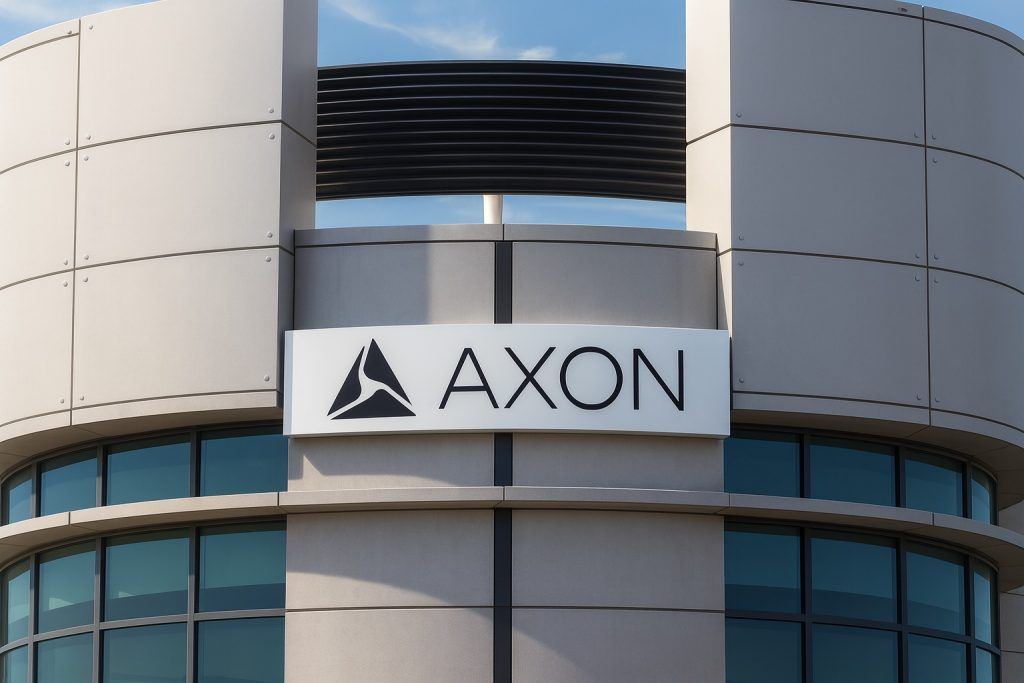- Wall Street Slips on Tech Troubles: U.S. stocks fell on Wednesday, with the S&P 500 down 0.5%, Nasdaq off 0.9%, and Dow Jones 0.7% lower [1]. The pullback came as Netflix shares plunged ~10% after a rare earnings miss and Tesla’s results disappointed, sparking broader market jitters [2] [3]. Major indexes are now barely positive for October, marking a sudden “speed bump” in 2025’s rally. Hong Kong’s tech index also slid 1.4% on the news, though London’s FTSE 100 surged 1.1% for its best day since July [4].
- Netflix Stock Nosedives: Streaming giant Netflix (NFLX) saw its stock collapse to around $1,116 per share at Wednesday’s close [5] – a 10% one-day drop – after posting third-quarter results that missed profit expectations due to a one-time $619 million tax charge in Brazil [6] [7]. The company slightly beat revenue forecasts and touted a strong upcoming content slate, but cautious guidance left investors underwhelmed [8] [9]. Netflix had rallied 360% in the past three years, so lofty valuation (≈40× forward earnings) meant “zero margin for error” – high expectations magnified the impact of this stumble [10] [11].
- Tesla Earnings Disappoint: Electric vehicle leader Tesla (TSLA) reported record Q3 sales ($28.1 billion revenue) yet profit sank ~37% year-on-year, missing Wall Street’s estimates [12] [13]. Higher costs – including $400 million from new tariffs – and shrinking regulatory credit revenue crimped margins [14]. Tesla’s stock, around $439 at Wednesday’s close [15], slid ~3–4% more after hours as CEO Elon Musk gave no full-year forecast and warned of demand pressures once U.S. EV tax credits expire [16] [17]. Analysts noted the mixed results “dished out just the right amount of good and bad news” to reinforce both bulls and bears, unlikely to change anyone’s stance on the high-flying $1.4 trillion company [18].
- Chipmakers & Tech Hit by Warnings: Weak spots emerged beyond FAANG stocks. Texas Instruments jolted the semiconductor sector by warning of soft chip demand, sending its shares down 7.6% and knocking peers like Microchip and NXP ~2–3% lower [19]. Rival Qualcomm plunged ~7% after news of a surprise China antitrust probe [20]. Even Apple underperformed the market Wednesday after a fresh EU antitrust complaint over its App Store practices [21]. A Reuters report that Washington may curb high-tech exports to China further unnerved investors, reviving trade-war fears on top of these earnings letdowns [22].
- Global Markets Mixed:European stocks proved resilient despite U.S. tech turmoil. Germany’s DAX index, near all-time highs (~24,700), only dipped 0.7% on Wednesday [23] [24]. Software giant SAP – a 17% weight in the DAX – initially fell ~4% after posting strong profits but cautious cloud sales guidance [25]. By Thursday, however, SAP’s stock rebounded 2%, helping the DAX stabilize around 24,200 [26]. “Strong gains in SAP’s shares after the earnings report supported the DAX,” noted one market report [27]. In Asia, South Korea’s KOSPI jumped 1.4% amid upbeat earnings [28], while China’s tech shares sagged on U.S. export curb worries. Meanwhile, oil prices spiked 2% (boosting energy stocks) and Treasury yields actually edged down as traders bet the Fed will stay cautious [29] [30].
- Outlook – Rally at a Crossroads: The late-2025 stock rally, fueled by an AI-driven tech boom, is being tested by these setbacks. Still, earnings season has been largely strong – about 87% of S&P 500 companies reporting so far beat forecasts (well above the ~67% historic average) [31]. Markets remain near record highs, but that also means they’re “more vulnerable to misses than beats” as one Reuters analyst observed [32] [33]. Top bankers like JPMorgan’s Jamie Dimon and even the IMF have cautioned that stretched valuations (the “Buffett indicator” of market cap vs GDP sits around 219%, above pre-crash levels) could spur a sharper correction ahead [34]. On the other hand, many on Wall Street see this pullback as a healthy pause. “After an extended rally and elevated investor sentiment, markets were vulnerable to negative surprises. We would view deeper pullbacks as opportunities to lean in,” advises Keith Lerner, co-Chief Investment Officer at Truist [35]. Some analysts even recommend buying the dip in names like Netflix, noting rivals’ price hikes give it room to raise rates and that its core business remains strong [36] [37]. With a crush of earnings (180 S&P companies) due next week and a key U.S. inflation report imminent [38] [39], volatility may persist – but if corporate profit momentum stays intact and trade tensions don’t escalate, bulls argue the 2025 rally could regain its footing.
Stocks Hit a Speed Bump Amid Tech Earnings Jitters
After a powerful run fueled by tech euphoria this year, global equities abruptly lost altitude this week. On October 22, the Dow sank 334 points (0.7%) to ~46,590, the S&P 500 shed 0.5%, and the Nasdaq Composite nearly 0.9% [40]. Investors faced a flurry of bad news: a shocking plunge in Netflix shares, underwhelming results from Tesla, and new trade and regulatory clouds hanging over the tech sector. “U.S. stocks fell on Wednesday, as [a report of potential U.S. export curbs to China] ratcheted up trade war fears and added to the gloom surrounding Netflix’s earnings miss,” Reuters noted in a market wrap [41]. The sudden risk-off tone has left the major indexes flat on the month of October [42], interrupting what had been a steady climb to record highs.
Macro factors compounded the anxiety. News that the Biden administration (under President Trump in Reuters’ reporting timeline) was mulling broader China export restrictions hit sentiment, particularly in semiconductor and tech hardware names [43]. At the same time, traders are navigating a unique environment: U.S. government data releases have been sparse due to an ongoing federal shutdown, and Treasury yields have been sliding despite still-elevated inflation [44] [45]. The 10-year yield dipped under 4.0%, reflecting expectations that the Federal Reserve might pivot to rate cuts soon if the labor market softens [46] [47]. Normally, falling yields are a boon for stocks, but on Wednesday their positive effect was outweighed by acute earnings disappointments in big-name companies.
Notably, value-oriented sectors outperformed amid the tech selloff – U.S. energy stocks jumped ~1.3% thanks to a 2% oil price spike (after a large crude inventory draw) [48] [49]. Defensive names and industrials still fell, however, as broader growth worries seeped in. “October has brought a spooky uptick in market swings,” observed Keith Lerner of Truist, pointing out that after such a long rally, the market was primed for a pullback on any bad news [50]. Indeed, investor sentiment had hit “extreme greed” levels by mid-month, and some froth was bound to be tested by even minor cracks in the bullish narrative. That test arrived this week in the form of high-profile tech stumbles.
Netflix’s Rare Earnings Miss Shocks Investors
Netflix, one of 2025’s star performers, delivered a jolt to Wall Street by falling short of earnings expectations – an infrequent misstep for the streaming leader. The company’s Q3 report revealed solid subscriber gains and in-line revenue of $8.54 billion, but profit was dented by an unexpected $619 million tax charge in Brazil, causing EPS to miss estimates [51] [52]. Executives said this charge related to a long-running tax dispute and was a one-off item [53]. Still, the damage was done: Netflix’s stock plunged 10.1% Wednesday, slicing over $50 billion off its market cap as shares closed near $1,116 [54].
This stumble was so startling because Netflix had been seen as nearly unstoppable lately. The stock had surged over 360% in the past three years [55], vastly outperforming old-media rivals like Disney and even tech giants Apple and Alphabet. Investors were used to Netflix crushing its targets, so much that the slightest disappointment now triggers an outsized reaction. “Shares have enjoyed a strong run this year, so expectations were already high, and with the valuation sitting above its long-term average, there’s added pressure not just to deliver but to exceed,” explained Matt Britzman, senior analyst at Hargreaves Lansdown [56]. In other words, Netflix’s rich valuation – roughly 40× forward earnings, a premium even among tech peers [57] – left no room for error.
And in the eyes of the market, Netflix erred. The company’s outlook for next quarter, while showing revenue growth to $11.96 billion (just above consensus) and hyping the upcoming final season of “Stranger Things”, wasn’t a blowout upgrade [58]. Netflix no longer reports quarterly subscriber additions (to focus on revenue), which also made some bulls nervous in searching for clear growth metrics [59] [60]. “With no subscriber numbers, some advocates are grasping at straws to find any sign of weakness,” noted analyst Paolo Pescatore, even as he argued Netflix “is faring much stronger than its rivals” [61] [62].
The company did highlight successes: its nascent ad-supported tier had its best quarter yet (though no figures given), and management hinted at potential future price increases, especially as competitors like Disney+ and Max (HBO) have hiked rates [63] [64]. In fact, some analysts see Netflix’s selloff as overdone. Evercore ISI suggested using the dip to accumulate shares, reasoning that rivals’ price hikes give Netflix “plenty of cover” to raise its own prices and boost revenue, supporting a bullish longer-term thesis [65] [66]. J.P. Morgan analysts likewise shrugged off the Brazilian tax hit as “noise” that doesn’t change the company’s fundamental story [67]. Nevertheless, at least three brokerages cut their price targets after the results [68], and Netflix’s shockwave clearly dragged down the broader market Wednesday [69]. It was a sobering reminder that even market darlings can stumble – and when they do, the ripple effects are profound given tech’s outsized role in index performance.
Tesla’s Big Miss Raises Growth vs. Margin Debate
Just hours after the Netflix drama, Tesla added to the market’s angst with a mixed earnings report that left bulls and bears both claiming validation. On paper, Tesla’s Q3 numbers had highs and lows. The good: revenue hit a record $28.1 billion, topping forecasts of ~$26.4 billion [70]. That was driven by a rush of vehicle deliveries in the U.S. as customers raced to beat an expiring EV purchase tax credit – Tesla had its highest quarter ever for sales. The bad: profit and margins fell sharply. Earnings per share came in at $0.50, missing the $0.55 consensus [71] [72]. Net income plunged 31% from a year ago [73].
Tesla’s costs soared, explaining the profit shortfall. On the earnings call, CFO Vaibhav Taneja revealed that new import tariffs (imposed by the Trump administration) on automotive parts cost Tesla over $400 million in Q3 alone [74]. Additionally, the company’s lucrative regulatory credit sales – essentially payments from other automakers buying credits to comply with emissions rules – dropped 44%, a decline that is expected to continue as U.S. EV credit rules change [75] [76]. Tesla also ramped up R&D spending by 50% year-on-year, pouring money into AI development, the Optimus robot project, and new vehicle programs [77]. All of this squeezed operating margin to just 7.6%, down from over 17% a year prior (as gleaned from context), a steep drop that concerned analysts on the call.
In response, Tesla’s stock – which had closed the regular session around $439 [78] (already down ~0.8% that day) – fell roughly 3.5–4% in after-hours trading once the earnings were released [79] [80]. By Thursday morning, shares were hovering near the mid-$420s. The company declined to issue a full-year 2025 delivery or profit forecast, citing uncertainty, which added to the cautious mood [81] [82]. CEO Elon Musk struck a sober tone about demand, warning that U.S. EV sales may cool in coming months now that a key $7,500 buyer tax credit has expired for Tesla’s models [83] [84]. Tesla has cut vehicle prices several times this year to stoke demand, and just this month introduced cheaper “Standard Range” versions of the Model 3 and Y with some features removed and ~$5k lower price tags [85]. While that should boost sales volumes, Musk acknowledged it will pinch profit per car, a trade-off investors are watching closely.
Reactions on Wall Street were divided. Some see Tesla’s results as a necessary investment phase, with short-term margin pain paving the way for long-term gains in AI, robotics and volume growth. Others worry that the EV leader’s best days of high profitability are behind it, especially as competition intensifies and economic conditions weaken. Market experts noted that Tesla’s Q3 had something for everyone. “Tesla dished out just the right amount of good and bad news to appease its fans while also providing enough evidence for its critics,” observed Shawn Campbell of Camelthorn Investments, adding “this earnings report isn’t going to change anyone’s mind on Tesla” [86]. Indeed, Tesla’s stock remains up significantly in 2025 (having more than doubled year-to-date before this pullback), so entrenched bulls remain ahead, while skeptics point to the 50% slide in Tesla’s operating income and lack of guidance as red flags. The immediate effect, however, was clear: Tesla’s miss rattled investors globally, even hitting European markets where Tesla’s fortunes influence major suppliers and index sentiment [87] [88].
Chips, Trade Fears and Other Sore Spots in Tech
The upheaval wasn’t limited to Netflix and Tesla. The semiconductor sector – another pillar of the 2025 tech story – flashed warning signs. On October 22, chipmaker Texas Instruments (TXN) plunged 7.6% after delivering a pessimistic outlook for coming quarters [89]. TI cited weakening demand for its analog chips, which go into everything from cars to industrial equipment, suggesting a broader manufacturing slowdown may be brewing. The news from this industry bellwether sent shockwaves: Microchip Technology and NXP Semiconductors tumbled ~2–3% in sympathy [90], and even Europe’s Infineon sank about 3% on Thursday’s open on read-through about softer global chip orders [91]. After a year of booming sales fueled by AI and electronics demand, chipmakers are now facing inventory gluts and more cautious spending – a potential sign that the tech cycle’s momentum is moderating.
In another blow, Qualcomm (QCOM) – a leading smartphone chip designer – saw its stock nosedive 7.3% in a single session after China launched an unexpected antitrust probe into the company [92]. The investigation raised fears of retaliatory actions in the U.S.–China tech rivalry. Geopolitics, in fact, played a major role in this week’s market stress. Late Tuesday, Reuters revealed the U.S. government is considering new restrictions on AI chip and semiconductor exports to China, a move that could cut off significant revenue streams for firms like Nvidia, AMD and Qualcomm [93]. This headline hit Asian markets hard – Hong Kong’s Hang Seng Tech index dropped 1.4% [94] – and it stoked anxiety among investors already wary of how far the U.S.–China trade war could escalate. Washington and Beijing have tentative talks scheduled in the coming weeks, but trust is low. As one example of the fragile backdrop: Apple, the world’s largest company, got hit with yet another EU complaint (this time from civil rights groups over App Store terms), and while not major in financial terms, it added to the sense that regulatory pressures are rising on Big Tech [95]. Apple’s stock ended Wednesday down about 1%, underperforming its peers [96].
Beyond tech, signals of consumer weakness and economic strain are emerging in earnings reports. In the retail sector, Target’s CEO announced his resignation after another quarter of falling sales, and the stock hovers near multi-year lows [97]. Consumer products giant Kimberly-Clark cut its outlook amid soft demand for household staples [98]. Even the travel industry is flagging: hotel operator Choice Hotels slid to a 52-week low on downgrades and a “Reduce” rating from analysts citing shrinking leisure demand [99]. These pockets of weakness underscore that the market’s resilience has been heavily concentrated in Big Tech and hype-driven areas like AI – so when tech falters, there aren’t many other places for investors to hide. This week’s stumble in stocks like Netflix and Tesla thus had an exaggerated effect on sentiment.
One area that hasn’t cracked (yet) is the AI-driven hype stocks – companies like Nvidia, which is still near all-time highs on record chip sales, and smaller speculative names like IonQ (quantum computing) which are up 700–1000% this year [100]. But even here, experts urge caution. “All of the quantum computer companies are overvalued – IONQ included,” one analyst warned in a recent note, highlighting how minuscule revenues can’t justify multi-billion valuations [101]. As of late October, the stock market’s overall valuation metrics are flashing red. The total U.S. equity market’s capitalization equals roughly 2.2× the nation’s GDP (the so-called Buffett Indicator), a level “far above the 200% ‘playing with fire’ threshold last seen before past crashes,” according to Nasdaq data [102]. Likewise, the popular Fear & Greed Index by CNN had been in “extreme greed” territory until this pullback. Translation: the market may have gotten ahead of itself, and bad news – like a big earnings miss or new trade barrier – can swiftly pierce investor complacency.
Europe and Asia: Pockets of Strength Amid Tech Turmoil
Interestingly, global markets showed a split personality this week. While U.S. indices and Asian tech stocks wavered, some regions saw gains. European equities proved relatively robust, thanks in part to company-specific drivers. In the UK, the FTSE 100 index leapt 1.1% on Wednesday [103], marking its best day in three months. Britain’s market was buoyed by a combination of factors: banking and energy shares rallied, and investors there cheered data showing UK inflation cooled more than expected in September (easing pressure on the Bank of England to raise rates further). Likewise, South Korea’s KOSPI rose 1.4% [104], led by its heavyweight Samsung Electronics, which climbed ahead of its earnings report on hopes of a memory chip market rebound. These pockets of strength provided a counterpoint to the selloffs elsewhere.
Germany’s DAX, Europe’s flagship index, had a volatile week but ultimately held near record territory. Ahead of a key earnings announcement from SAP – Germany’s largest tech company – the DAX slipped about 0.7% on Wednesday amid the global tech jitters [105]. SAP itself, despite delivering a 12% jump in Q3 profit and raising its full-year outlook, issued cautious commentary that cloud computing demand might only hit the low end of targets given a “gloomy” economy [106]. That initially sent SAP shares down ~4% in after-hours trading Wednesday as investors digested the cloud growth downgrade [107]. But by the next morning (Oct 23), sentiment shifted – SAP’s stock rebounded roughly 2% at the Frankfurt open after analysts deemed the results “better than feared” on second look [108] [109]. This intraday whiplash in SAP highlights how skittish traders are: one piece of good news can still revive confidence quickly. With SAP bouncing back, the DAX actually opened slightly higher Thursday (up ~0.2% by midday) [110] [111], showing that Europe’s bull case (strong earnings and lower valuations than U.S. peers) remains intact for now.
That said, European markets aren’t immune to U.S. tech tremors. SAP’s CFO admitted to a “gloomy environment” in Europe [112], and other sectors felt pressure: for example, European chipmakers like ASML and Infineon fell in sympathy with the U.S. semiconductor rout [113]. Auto stocks also wobbled amid Tesla’s margin warning (though some got a boost from strong earnings by BMW and others earlier in the month). Geopolitics looms in Europe too – the ongoing war in the Middle East and an uncertain outlook for China’s economy have made investors cautious. Still, with inflation trending down and central banks like the ECB likely done with rate hikes, some see Europe’s market setting up for a year-end rebound.
In Asia, markets were mixed. China’s indexes are struggling with domestic economic concerns and the overhang of U.S. trade policies – the export curb news only added to those woes. Conversely, Japan has been a bright spot: Tokyo’s Nikkei index is near multi-decade highs, aided by a weak yen boosting exporters and anticipation of a large government stimulus package. Japan’s new Prime Minister is reportedly preparing a sweeping spending plan to tackle inflation and support growth [114] [115], which has bolstered Japanese stocks even as others falter. Meanwhile, emerging markets are seeing divergent fortunes; India’s Nifty index is around record levels thanks to robust foreign inflows, whereas markets like Brazil have been choppier. All told, the global picture underscores a key theme: 2025’s rally has been led disproportionately by U.S. tech, so any hiccup there sends tremors worldwide – but some regions and sectors are starting to decouple and find their footing.
Forecast: Cautious Optimism – If Earnings Deliver
Looking ahead, the big question is: was this just a blip, or the start of a broader downtrend? Thus far, most analysts are leaning toward the former – a healthy breather for a hot market – albeit with the caveat that risks are rising. The good news is that corporate earnings remain largely strong. As of this week, about one-fifth of S&P 500 companies have reported Q3 results, and a striking 87% have beaten profit estimates [116]. Those beats are coming against tempered expectations, but they show that the economy (and corporate America’s efficiency) is holding up better than feared. In fact, many tech giants are still posting stellar growth – Microsoft, Google, and others are on deck to report in coming days, and if they mirror early reporters like Nvidia (56% revenue jump last quarter) [117] [118] or Meta and AMD (both up ~80% YTD stock-wise on AI enthusiasm) [119], the overall market rally could resume swiftly. “There remain many reasons to be bullish on the market,” argues Nicholas Bohnsack at Strategas Research. Chief among them, corporate profits have continued to follow through on estimates that have been revised higher.” [120] In other words, earnings trends – the ultimate driver of stocks – are still positive.
Another source of optimism: central banks are turning friendlier. The Federal Reserve has signaled it may be done raising rates, especially if inflation shows signs of cooling and job growth slows. Fed Chair Jerome Powell recently emphasized that policy will prioritize employment risks over inflation at this stage [121] [122], which markets interpret as a dovish lean. Bond yields have accordingly pulled back from their highs – the 20-year Treasury yield fell in recent days during a debt auction that saw strong demand [123]. Lower yields ease pressure on stock valuations and provide breathing room for growth stocks. In Europe too, the ECB is at or near peak rates, and any hints of rate cuts in 2024 could further boost sentiment.
However, nobody is declaring “all clear”. The concentration of market gains in a handful of tech names remains a vulnerability. “Elevated equity valuations make the U.S. market vulnerable to negative surprises,” warned a Bloomberg Intelligence outlook, noting that the S&P 500’s forward P/E near 20 is well above historical norms [124] [125]. The events of this week – Netflix’s hiccup and Tesla’s margin squeeze – illustrate how those surprises can suddenly materialize. There are also macro wildcards on the horizon. Geopolitical strife (from Ukraine to the Middle East) could affect energy prices and investor confidence. U.S.–China relations are a powder keg that could impact everything from tech supply chains to consumer demand if tensions worsen. And the lagged impact of this year’s global rate hikes is still filtering through economies; some fear a mild U.S. recession in 2026 is possible, which isn’t fully priced into stocks.
For now, though, many strategists advise staying the course but with prudence. “After an extended rally…markets were vulnerable to negative surprises. We would view deeper pullbacks as opportunities,” says Truist’s Lerner, who still recommends high-quality stocks on dips [126]. Indeed, history shows that when earnings are trending up and the Fed is on hold or easing, equities often weather interim volatility and continue climbing. The coming days will be telling: a flood of tech earnings (from the likes of Amazon, Apple, and Google’s parent Alphabet) will either reassure investors or raise new red flags. Additionally, a key U.S. inflation report on Friday will update core price trends [127] – any sign of cooling could further bolster the “Fed pause” narrative, while a surprise uptick might spook bonds and stocks alike.
Bottom Line: The stock market’s rally has hit a bump in late October, jolted by high-profile disappointments at Netflix and Tesla and a resurgence of trade jitters. Yet the broader bull case – strong overall earnings, receding inflation, and tech-driven growth – is not broken. As long as corporate America continues to deliver on profits (and most are, so far), many experts believe this dip will prove temporary. “Perhaps this is a needed reset,” says one fund manager, “reminding everyone that trees don’t grow to the sky. But the forest is still healthy.” With valuations rich, investors will be more discerning – rewarding companies that clear a high bar, and punishing those that falter – making stock-picking crucial. The next few weeks could well determine if 2025’s market story ends as “the year of AI-fueled gains” or if an overdue correction takes some shine off the rally. For now, cautious optimism prevails that the former narrative will win out, so long as earnings and the economy avoid any major negative surprises.
Sources: Financial markets update and analysis by Reuters [128] [129], Yahoo Finance [130] [131], The Wall Street Journal and MarketWatch reports, and expert commentary from TechStock² and Bloomberg [132] [133]. Further details from company earnings releases and analyst insights via Reuters, TS², and other financial news outlets have been incorporated [134] [135].
References
1. www.reuters.com, 2. www.reuters.com, 3. www.reuters.com, 4. www.reuters.com, 5. stockanalysis.com, 6. www.reuters.com, 7. ts2.tech, 8. www.reuters.com, 9. www.reuters.com, 10. www.reuters.com, 11. www.reuters.com, 12. www.reuters.com, 13. www.reuters.com, 14. www.reuters.com, 15. www.morningstar.com, 16. www.reuters.com, 17. www.reuters.com, 18. www.reuters.com, 19. ts2.tech, 20. ts2.tech, 21. www.reuters.com, 22. www.reuters.com, 23. ts2.tech, 24. ts2.tech, 25. ts2.tech, 26. ts2.tech, 27. ts2.tech, 28. www.reuters.com, 29. www.reuters.com, 30. www.reuters.com, 31. www.reuters.com, 32. www.reuters.com, 33. www.reuters.com, 34. ts2.tech, 35. www.swissinfo.ch, 36. www.reuters.com, 37. www.reuters.com, 38. www.reuters.com, 39. www.reuters.com, 40. www.reuters.com, 41. www.reuters.com, 42. www.reuters.com, 43. www.reuters.com, 44. www.reuters.com, 45. www.reuters.com, 46. www.reuters.com, 47. www.reuters.com, 48. www.reuters.com, 49. www.reuters.com, 50. www.swissinfo.ch, 51. www.reuters.com, 52. www.reuters.com, 53. www.reuters.com, 54. stockanalysis.com, 55. www.reuters.com, 56. www.reuters.com, 57. www.reuters.com, 58. www.reuters.com, 59. www.reuters.com, 60. www.reuters.com, 61. www.reuters.com, 62. www.reuters.com, 63. www.reuters.com, 64. www.reuters.com, 65. www.reuters.com, 66. www.reuters.com, 67. www.reuters.com, 68. www.reuters.com, 69. www.reuters.com, 70. www.reuters.com, 71. www.reuters.com, 72. www.reuters.com, 73. ts2.tech, 74. www.reuters.com, 75. www.reuters.com, 76. www.reuters.com, 77. www.reuters.com, 78. www.morningstar.com, 79. www.reuters.com, 80. www.reuters.com, 81. www.reuters.com, 82. www.reuters.com, 83. www.reuters.com, 84. www.reuters.com, 85. www.reuters.com, 86. www.reuters.com, 87. ts2.tech, 88. ts2.tech, 89. ts2.tech, 90. ts2.tech, 91. ts2.tech, 92. ts2.tech, 93. www.reuters.com, 94. www.reuters.com, 95. www.reuters.com, 96. www.reuters.com, 97. ts2.tech, 98. ts2.tech, 99. ts2.tech, 100. ts2.tech, 101. ts2.tech, 102. ts2.tech, 103. www.reuters.com, 104. www.reuters.com, 105. ts2.tech, 106. ts2.tech, 107. ts2.tech, 108. ts2.tech, 109. ts2.tech, 110. ts2.tech, 111. ts2.tech, 112. ts2.tech, 113. ts2.tech, 114. www.reuters.com, 115. www.reuters.com, 116. www.reuters.com, 117. ts2.tech, 118. ts2.tech, 119. ts2.tech, 120. www.swissinfo.ch, 121. www.reuters.com, 122. www.reuters.com, 123. www.reuters.com, 124. finance.yahoo.com, 125. www.bloomberg.com, 126. www.swissinfo.ch, 127. www.reuters.com, 128. www.reuters.com, 129. www.reuters.com, 130. stockanalysis.com, 131. www.bloomberg.com, 132. www.swissinfo.ch, 133. ts2.tech, 134. www.reuters.com, 135. www.reuters.com








